

Your Crowdsourcing Platform. Getting the Most from Your Crowdsourcing Initiative. By: David | September 23, 2010 When running a crowdsourcing contest, which strategy makes the most sense?
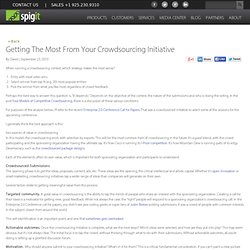
Entry with most votes wins Select winner from top N (e.g. 20) most popular entries Pick the winner from what you like most, regardless of crowd feedback Perhaps the best way to answer this question is, “It depends.” Depends on the objective of the contest, the nature of the submissions and who is doing the voting. In the post Four Models of Competitive Crowdsourcing, there is a discussion of these various conditions. For purposes of the analysis below, I’ll refer to the recent Enterprise 2.0 Conference Call for Papers. I generally think the best approach is this: In this model, the crowdsourcing ends with selection by experts. Brightidea: The Global Leader Cloud-Based Enterprise Innovation Management.
Crowdsourcing + Smartsheet = Smartsourcing. Crowdsourcing + Smartsheet = Smartsourcing Smartsheet is the only online software collaboration tool that makes it possible to connect to an on-demand workforce.
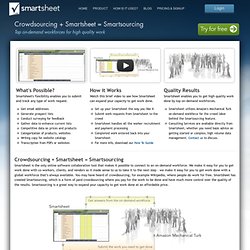
Kostenlos als Clickworker registrieren und online Geld verdienen. Logo Design, Web Design and Writing by the World's Best Creative Team. Crowdsourcing. Crowdsourcing: 5 Reasons It's Not Just For Startups Any More. Next-generation enterprises looking to drive efficiency and innovation have recently been able to tap into online communities to offload work.

For the first time since outsourcing became prevalent in the 90s -- making it easier to move tasks out to partners that could do something better or more cheaply than you could -- businesses now have a new, potent, and often far cheaper option thanks to the Web. Frequently referred to as crowdsourcing, and a darling of the Web 2.0 industry, it has recently come of age as the tools and marketplaces for on-demand work capacity on the network have expanded far beyond the early volunteer communities that originally proved out the concepts. These pioneers, which include the world of open source software and online services such as YouTube and Threadless, get most of their value from a large group of people or community through the simple use of an open invitation.
Related: Crowdsourcing is one of 18 key topics for IT and business leaders this year. Crowdsourcing and Crowdfunding - The Industry Website. ROBOTICA/ Ecco l'I-SWARM, lo sciame dall'intelligenza artificiale. On Dynamic Evolution of Industry Agglomeration Based on Swarm Intelligence. We Swarm - L'Impresa che fa sciame. Mini-robot, navi appoggio in superficie, strategie dello sciame, vespe, formiche, organizzazione e consegna - Articoli articoli - Messaggiamo.Com.
I robot sono per ogni.

La tecnologia TV ora ospita i Bots di battaglia che è un grosso successo con i visori e disegna le folle grandi quanto WFB che lotta. Non ho l'età per i Social Media. Polly Pearson's Blog. Bonabeau/DeAngelo/Bandte/Orme/Fenty/VanPelt/Khatib/Arias/Shargel. Agent-based modeling for organizational design: three real-world case studies Multi-agent models of human organizations are ideally suited to play what-if scenarios and organizational designs.

Jean-Louis Deneubourg. Predictive Analytics Using Agent-based Modeling. SWARM-LIKE DYNAMICS AND THEIR USE IN ORGANIZATIONS AND MANAGEMENT Vladimir Dimitrov. Self-organization. Self-organization occurs in a variety of physical, chemical, biological, robotic, social and cognitive systems.

Common examples include crystallization, the emergence of convection patterns in a liquid heated from below, chemical oscillators, swarming in groups of animals, and the way neural networks learn to recognize complex patterns. Overview[edit] The most robust and unambiguous examples[1] of self-organizing systems are from the physics of non-equilibrium processes. Self-organization is also relevant in chemistry, where it has often been taken as being synonymous with self-assembly. The concept of self-organization is central to the description of biological systems, from the subcellular to the ecosystem level. Self-organization usually relies on three basic ingredients:[3] Strong dynamical non-linearity, often though not necessarily involving positive and negative feedbackBalance of exploitation and explorationMultiple interactions. It's Time to Invert the Management Pyramid - Vineet Nayar. By Vineet Nayar | 1:57 PM October 8, 2008 As time passes by, people and things change.
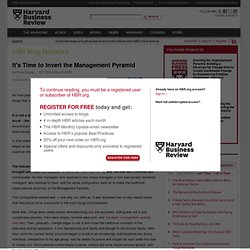
Now, what if time passes by and people change, but things that should change, don’t? It is not a stationary relic I’m talking about. I’m talking about the brand new dinosaur on the block – the classical management pyramid. Time has come to dismantle it and adapt to a new evolutionary and unstructured model that leverages the team effect to ensure that companies can lead change rather play catch up or be left behind. Is your organization ready to “swarm”? Gartner has published a fascinating list of how the world of work may change as we move forward.
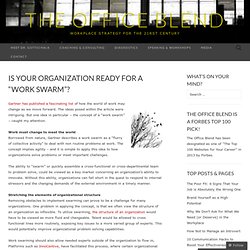
The ideas posed within the article were intriguing. But one idea in particular – the concept of a “work swarm” – caught my attention. Work must change to meet the world Borrowed from nature, Gartner describes a work swarm as a “flurry of collective activity” to deal with non routine problems at work. The concept implies agility – and it is simple to apply this idea to how organizations solve problems or meet important challenges. The ability to “swarm” or quickly assemble a cross-functional or cross-departmental team to problem solve, could be viewed as a key marker concerning an organization’s ability to innovate.
Stretching the elements of organizational structure Removing obstacles to implement swarming can prove to be a challenge for many organizations. Work swarming should also allow needed experts outside of the organization to flow in. Says the World of Work Will Witness 10 Changes During the Next 10 Years. Egham, UK, , August 4, 2010 View All Press Releases Gartner Analysts to Discuss the Changing Nature of Work at Gartner Portals, Content and Collaboration Summit 2010 in London, UK, September 15-16 The world of today is dramatically different from 20 years ago and with the lines between work and non-work already badly frayed, Gartner, Inc. predicts that the nature of work will witness 10 key changes through 2020.
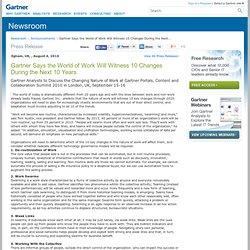
Organizations will need to plan for increasingly chaotic environments that are out of their direct control, and adaptation must involve adjusting to all 10 of the trends. “Work will become less routine, characterized by increased volatility, hyperconnectedness, 'swarming' and more,” said Tom Austin, vice president and Gartner fellow. By 2015, 40 percent or more of an organization’s work will be ‘non-routine’, up from 25 percent in 2010. 1. Watchlist: Continuing Changes in the Nature of Work, 2010-2020. Already a Gartner client?

Sign in to view this research document. Forgot username or password? Purchase this Document Price: $95.00 USD (PAGES: 5) You will need to create an account on Gartner.com. Summary.